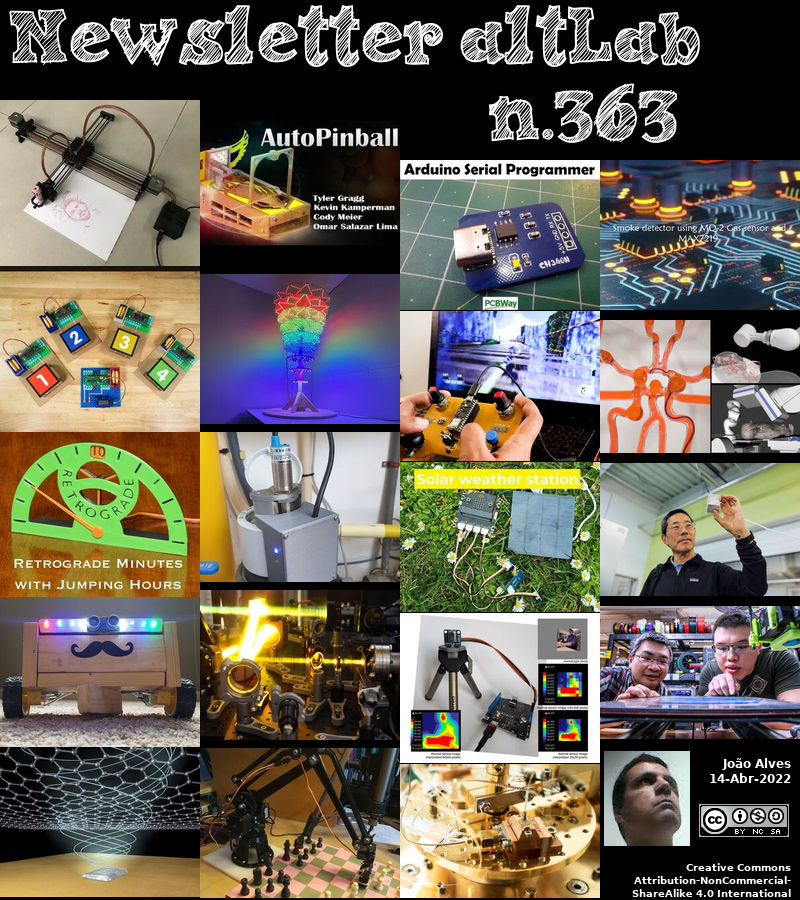2022-04-14 - Nº 363
Editorial
Esta é a Newsletter Nº 363 que se apresenta com o mesmo formato que as anteriores. Se gostar da Newsletter partilhe-a!
Todas as Newsletters encontram-se indexadas no link.
Esta Newsletter tem os seguintes tópicos:
Faz hoje anos que nascia, em 1629, o físico e astrónomo holandês Christiaan Huygens. Ele fundou a teoria das ondas da luz, descobriu a verdadeira forma dos anéis de Saturno, e contribuiu para a ciência da dinâmica - o estudo da acção das forças sobre os corpos. Usando uma lente que ele mesmo moeu, a 25 de Março de 1655, descobriu a primeira lua de Saturno, mais tarde denominada Titã. Em 1656, patenteou o primeiro relógio pendular, que desenvolveu para permitir a medição exacta do tempo enquanto observava os céus. Cristiaan Huygens estudou a relação do comprimento de um pêndulo com o seu período de oscilação (1673) e declarou teorias sobre a força centrífuga em movimento circular que influenciaram Sir Isaac Newton na formulação da sua Lei da Gravidade. Huygens também estudou e desenhou os primeiros mapas de Marte. A 14 de Janeiro de 2005, uma sonda espacial da NASA, com o nome de Huygens, aterrou em Titan.
Faz também hoje anos que nascia, em 1898, o Engenheiro electrotécnico norte-americano Harold Stephen Black. Ele descobriu e desenvolveu o princípio do feedback negativo, no qual a saída de amplificação é introduzida de novo na entrada, produzindo assim uma amplificação quase sem distorções e constante. Em 1921, Black juntou-se ao precursor dos Laboratórios Bell, na cidade de Nova Iorque, trabalhando na eliminação da distorção. Depois de seis anos de persistência, Black concebeu o seu amplificador de feedback negativo num deslocamento pendular para trabalhar a bordo do ferry. Basicamente, o conceito envolvia a saída dos sistemas de alimentação para a entrada como um método de controlo do sistema. O princípio encontrou aplicações generalizadas na electrónica, incluindo electrónica industrial, militar, e de consumo, armamento, computadores analógicos, e dispositivos biomecânicos tais como pacemakers.
Por fim, faz hoje anos que nascia, em 1927, o químico neozelandês-americano Alan G. MacDiarmid. Ele partilhou o Prémio Nobel da Química de 2000 (com Alan Heeger e Hideki Shirakawa) "para a descoberta e desenvolvimento de polímeros condutores". Os plásticos (formados de unidades repetidas em moléculas de polímeros de cadeia longa) na maioria das vezes não conduzem electricidade, e são utilizados para isolamento. No final dos anos 70, estes cientistas conceberam materiais de polímeros que eram semi-condutores, capazes de conduzir electricidade. As aplicações práticas incluem agora polímeros condutores em janelas "inteligentes" capazes de excluir a luz solar, díodos emissores de luz, células solares e ecrãs para telemóveis e pequenos ecrãs de televisão. A investigação tem sido estimulada para tentar produzir transístores constituídos por moléculas individuais com as quais se pode reduzir drasticamente o tamanho dos computadores.
Em 1611, a palavra "telescópio" foi utilizada pela primeira vez em público pelo Príncipe Federico Cesi num banquete realizado pela sociedade científica pioneira, a Academia de Linceanos (ou Luchs, da qual foi fundador). Foi realizada para homenagear Galileu, numa grande propriedade na encosta de uma colina. Depois de Galileu ter mostrado aos convidados os satélites de Júpiter, outras maravilhas celestiais, e até uma inscrição num edifício a três milhas de distância. Embora o nome tenha sido anunciado por Cesi para baptizar o instrumento de Galileu, a palavra telescópio (em italiano) foi talvez concebida por um poeta-teólogo grego, que por acaso estava presente, a partir de palavras gregas* (tele = longínquo e scopeo = ver).
Em 1932, o átomo foi dividido por um feixe de prótons sobre um alvo de lítio. Dois físicos, o inglês Sir John Douglas Cockcroft e o irlandês Errnest Walton tinham desenvolvido o primeiro acelerador de partículas nucleares (o gerador Cockcroft-Walton, pelo qual partilharam o Prémio Nobel da Física de 1951. O acelerador foi construído numa sala em desuso no Laboratório Cavendish. Com este equipamento, Walton conseguiu ser o primeiro a dividir o átomo (o seu núcleo). Quando um protão do feixe fornecido pelo acelerador atingiu um núcleo de lítio, a sua combinação instável desintegrou-se em duas partículas alfa (núcleos de hélio). Walton observou as cintilações características das partículas alfa numa tela de sulfureto de zinco.
E nesta semana que passou foi lançada a primeira missão tripulada totalmente privada para a estação espacial internacional. Um foguetão SpaceX Falcon 9 lançou o Ax-1, uma missão da empresa Axiom Space, com sede em Houston, no dia 8 de Abril às 11:17 EDT (1517 GMT) do Centro Espacial Kennedy da NASA, na Costa Espacial da Florida. Nenhum dos quatro tripulantes do Ax-1 é um passageiro espacial do governo. Michael López-Alegría (comandante da missão e ex-astronauta da NASA), Eytan Stibbe (ex-piloto da aviação israelita), Larry Connor (investidor e piloto particular norte-americano) e Mark Pathy (empresário canadiano) vão estar na EEI durante nove dias a fazer experiências científicas e actividades de cariz educativo e comercial.
Na Newsletter desta semana apresentamos diversas noticias, artigos científicos, projetos de maker e alguns vídeos interessantes.
 João Alves ([email protected])
João Alves ([email protected])
O conteúdo da Newsletter encontra-se sob a licença  Creative Commons Attribution-NonCommercial-ShareAlike 4.0 International License.
Creative Commons Attribution-NonCommercial-ShareAlike 4.0 International License.
Novidades da Semana

SpaceX launches Ax-1, the 1st fully private astronaut mission to the space station
"A pioneering astronaut mission is on its way to the International Space Station. A SpaceX Falcon 9 rocket launched Ax-1, a mission from Houston-based company Axiom Space, today (April 8) at 11:17 a.m. EDT (1517 GMT) from NASA's Kennedy Space Center here on Florida's Space Coast. None of Ax-1's four crewmembers are government spaceflyers. It's the first-ever fully private crewed mission to launch to the orbiting lab. "Together, a new chapter begins," Axiom Space's Jon Rackham said during a webcast of the launch today. "Godspeed, Ax-1!"" [...]
Outras Notícias

Webb Telescope’s Coldest Instrument Reaches Operating Temperature
"With help from a cryocooler, the Mid-Infrared Instrument has dropped down to just a few degrees above the lowest temperature matter can reach and is ready for calibration. NASA’s James Webb Space Telescope will see the first galaxies to form after the big bang, but to do that its instruments first need to get cold – really cold. On April 7, Webb’s Mid-Infrared Instrument (MIRI) – a joint development by NASA and ESA (European Space Agency) – reached its final operating temperature below 7 kelvins (minus 447 degrees Fahrenheit, or minus 266 degrees Celsius). Along with Webb’s three other instruments, MIRI initially cooled off in the shade of Webb’s tennis-court-size sunshield, dropping to about 90 kelvins (minus 298 F, or minus 183 C). But dropping to less than 7 kelvins required an electrically powered cryocooler. Last week, the team passed a particularly challenging milestone called the “pinch point,” when the instrument goes from 15 kelvins (minus 433 F, or minus 258 C) to 6.4 kelvins (minus 448 F, or minus 267 C)." [...]

STMicroelectronics’ integrated automotive audio amplifier combines high-definition sound with class-G efficiency
"STMicroelectronics’ TDA7901 automotive amplifier integrates a buck controller for class-G power switching and supports high-definition audio, a market-unique combination for great listening and high efficiency. In class-G operation, the TDA7901 buck controller automatically optimizes the voltage supplied to the bridge-tied load (BTL) power stage depending on the audio-signal level. The resulting smooth, analog sound comes with near-class-D efficiency at normal listening levels. Because the power dissipation is much lower compared with a conventional class-A/B amplifier, the heatsink requirement is optimized. Integrating the buck controller in the IC contributes to reducing system size and weight. It also cuts the bill of materials, simplifies circuit design, and saves developing firmware to control the voltage rail." [...]

Renesas Launches Virtual Development Environment for Fast Automotive Application Software Development and Evaluation
"New Environment Allows Customers to Bring Leading-Edge Software to Market Quickly Renesas Electronics Corporation (TSE:6723), a premier supplier of advanced semiconductor solutions, today announced the launch of a virtual development environment that enables advance development and operational evaluation of automotive application software to support the latest requirements of electrical/electronic architecture (E/E architecture). The environment includes a Virtual Turnkey Platform, which allows engineers to develop application software before devices or evaluation boards are available. Additionally, the new environment offers a Multicore Debug and Trace Tool, which enables users to analyze and evaluate the operation of their software as if it were running on an actual chip. These tools will allow customers to kick-start development and get to market faster with leading-edge software. “With the evolution of E/E architecture, there is an increasing demand for software design that can maximize performance at a system level. At the same time, the increasing time and cost associated with software development have become a big challenge,” said Hiroshi Kawaguchi, Vice President, Automotive Software Development Division at Renesas." [...]
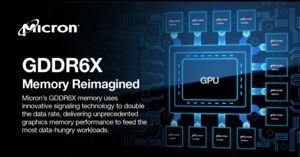
Micron GDDR6X Increases Bandwidth and Capacity
"16Gb memory supports industry-leading speeds up to 24Gb/s, ideal for gamers and content creators Micron Technology, Inc. (Nasdaq: MU), today announced the volume production of its new 16Gb GDDR6X memory, which is now shipping in the NVIDIA® GeForce® RTX 3090 Ti graphics card. The latest GDDR6X memory, available only from Micron, features twice the capacity and up to 15% higher performance over the previous 8Gb version. These additional capabilities mean end users can experience razor-sharp visuals, higher frame rates and outstanding performance in memory-intensive applications like gaming and content creation. Today Micron extends its performance leadership by providing a new graphics memory with 16Gb capacity and running at an industry-best 21Gb/s in the GeForce RTX 3090 Ti. With a performance roadmap up to 24Gb/s, GDDR6X is ready for data-hungry applications of the future. Additionally, Micron’s innovative use of PAM4 signal techniques in GDDR6X make it more power efficient than any of the GDDR6 products publicly available.1 “The industry-leading capabilities of Micron’s GDDR6X memory help bring new levels of realism and performance to the most demanding applications,” said Mark Montierth, vice president and general manager of High-Performance Memory and Networking at Micron." [...]

Renesas Introduces Industry’s First PCIe Gen6 Clock Buffers and Multiplexers
"New Devices from the Timing Leader Offer High Output Count, Small Packages, and Design Margin for Future Requirements; Complete Industry’s First PCIe Gen6 Timing Solution. Renesas Electronics Corporation (TSE:6723), a premier supplier of advanced semiconductor solutions, today introduced the first clock buffers and multiplexers that meet stringent PCIe Gen6 specifications. Renesas, the industry’s undisputed leader in timing solutions, is offering 11 new clock buffers and 4 new multiplexers. The new devices, which also support and provide extra margin for PCIe Gen5 implementations, complement Renesas’ low-jitter 9SQ440, 9FGV1002 and 9FGV1006 clock generators to offer customers a complete PCIe Gen6 timing solution for data center/cloud computing, networking and high-speed industrial applications. The PCIe Gen6 standard supports extremely high data rates of 64 GT/s while requiring very low clock jitter performance of less than 100fs RMS. Renesas’ new RC190xx clock buffers and RC192xx multiplexers have PCIe Gen6 additive jitter specs of only 4fs RMS, making them virtually noiseless, and thereby future-proofing customer designs for the next generation of industry standards." [...]

Introducing the Arduino secure boot
"To increase the range of features and firmware safety of Arduino products, we decided to release a new bootloader based on MCUboot. Here is a quick introduction on everything you need to know about it. Introduction to MCUboot MCUboot is a secure bootloader solution offering fail-safe firmware authentication and secure firmware update mechanism, plus many other functionalities such as update encryption, update rollback, and application bootstrap. MCUboot does not depend on any specific hardware and operating system; as of writing, the following RTOS are supported: zephyr, nuttx, mynewt, and mbed. Our efforts have been focused on keeping things simple and reusing the existing OTA design in place on Arduino boards. MCUboot base blocks To access the microcontroller flash, MCUboot relies on the operating system driver layer." [...]
Ciência e Tecnologia
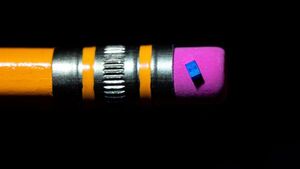
TU Delft and Intel drink a toast to the qubit
"The new building blocks of the quantum computer of the future are being produced in a present-day chip factory. Researchers from QuTech — a TU Delft and TNO collaboration — and Intel showed that this is possible. They achieved this major technological feat through close collaboration and extensive knowledge sharing, and cracked open the champagne in an online toast to this milestone. At first glance, the Intel buildings near the American city of Portland seem pretty bland, looking like enormous grey shoe boxes that serve as distribution centres for packages or foodstuffs. Not a place where you'd expect to find groundbreaking technological research taking place. Yet that's precisely what's going on within these grey walls." [...]

The side effects of quantum error correction and how to cope with them
"It is well established that quantum error correction can improve the performance of quantum sensors. But new theory work cautions that, unexpectedly, the approach can also give rise to inaccurate and misleading results — and shows how to rectify these shortcomings. Quantum systems can interact with one another and with their surroundings in ways that are fundamentally different from those of their classical counterparts. In a quantum sensor, the particularities of these interactions are exploited to obtain characteristic information about the environment of the quantum system, for instance the strength of a magnetic and electric field in which it is immersed. Crucially, when such a device suitably harnesses the laws of quantum mechanics, then its sensitivity can surpass what is possible, even in principle, with conventional, classical technologies. Unfortunately, quantum sensors are exquisitely sensitive not only to the physical quantities of interest, but also to noise." [...]

70 years of electronic computing
"Seventy years ago this spring, the first fully electronic computer at what is today Los Alamos National Laboratory came online. Called the MANIAC, it was constructed when electronic computing and its associated industry were still in their infancy. Early computer centers like Los Alamos had to build their own systems and invent the methods for using them. This pioneering effort gave Los Alamos and the few places like it an outsized influence on the emerging electronic computing field, shaping the computing technologies and methods we experience today. One of the first electronic computers in the world, the MANIAC represented a substantial human investment at Los Alamos to develop the computing methods and tools capable of serving the Lab’s complex problems in weapons science. This meant that people with a variety of backgrounds and skill sets had to invent concepts and practices that are commonplace today, but were new and profound in their implications in the 1950s." [...]

Intelligent traffic lights for optimal traffic flow
"Traffic jams and long waiting times at junctions in city centres are part of our everyday lives - be it as pedestrians, public transport users or motorists. ETH spin-off Lumisera promises a significantly improved traffic flow with self-regulated traffic light systems. Every major city is familiar with the problem: junctions where traffic jams and delays occur time and again. Engineers and authorities develop signal plans for the control of complex traffic light systems for every time of day and traffic volume. The aim is to find the best possible variant for all road users at any time of day. If required, green phases can be used to prioritise buses or pedestrians." [...]
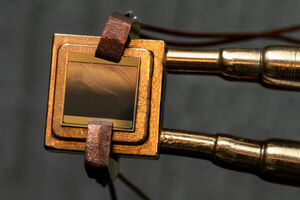
A new heat engine with no moving parts is as efficient as a steam turbine
"The design could someday enable a fully decarbonized power grid, researchers say. Engineers at MIT and the National Renewable Energy Laboratory (NREL) have designed a heat engine with no moving parts. Their new demonstrations show that it converts heat to electricity with over 40 percent efficiency — a performance better than that of traditional steam turbines. The heat engine is a thermophotovoltaic (TPV) cell, similar to a solar panel’s photovoltaic cells, that passively captures high-energy photons from a white-hot heat source and converts them into electricity. The team’s design can generate electricity from a heat source of between 1,900 to 2,400 degrees Celsius, or up to about 4,300 degrees Fahrenheit. The researchers plan to incorporate the TPV cell into a grid-scale thermal battery." [...]
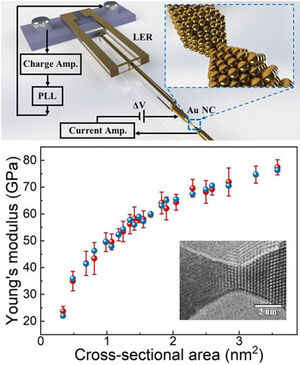
No Small Measure: Probing the Mechanics of Gold Contacts at the Nanoscale
"New method allows scientists to precisely measure the strength of nanomaterials only a few atoms thick The physical properties at the surface of nanomaterial structures become much more prominent as they approach atomic scales. In a recent study, Japanese scientists accurately measured, for the first time, the mechanical strength at the surface of gold nanocontacts as they were progressively stretched down to only a few atoms. Their findings, along with their innovative nanomechanics measurement method, could open doors to nanoelectromechanical systems and next-generation sensors. Miniaturization lies at the heart of countless technological advances. It is undeniable that as devices and their building blocks get smaller, we manage to unlock new functionalities and come up with unprecedented applications. However, with more and more scientists delving into materials with structures on the atomic scale, the gaps in our current understanding of nanomaterial physics are becoming more prominent." [...]
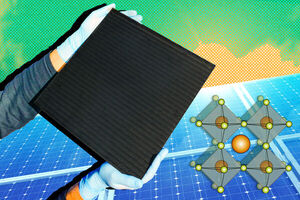
Engineers enlist AI to help scale up advanced solar cell manufacturing
"Perovskite materials would be superior to silicon in PV cells, but manufacturing such cells at scale is a huge hurdle. Machine learning can help. Perovskites are a family of materials that are currently the leading contender to potentially replace today’s silicon-based solar photovoltaics. They hold the promise of panels that are far thinner and lighter, that could be made with ultra-high throughput at room temperature instead of at hundreds of degrees, and that are cheaper and easier to transport and install. But bringing these materials from controlled laboratory experiments into a product that can be manufactured competitively has been a long struggle. Manufacturing perovskite-based solar cells involves optimizing at least a dozen or so variables at once, even within one particular manufacturing approach among many possibilities." [...]
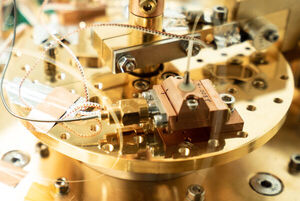
Researchers Generate High-Quality Quantum Light with Modular Waveguide Device
"New approach could enable faster and more practical optical quantum computers For the first time, researchers have successfully generated strongly nonclassical light using a modular waveguide-based light source. The achievement represents a crucial step toward creating faster and more practical optical quantum computers. “Our goal is to dramatically improve information processing by developing faster quantum computers that can perform any type of computation without errors,” said research team member Kan Takase from the University of Tokyo. “Although there are several ways to create a quantum computer, light-based approaches are promising because the information processor can operate at room temperature and the computing scale can be easily expanded.” In the Optica Publishing Group journal Optics Express, a multi-institutional team of researchers from Japan describe the waveguide optical parametric amplifier (OPA) module they created for quantum experiments. Combining this device with a specially designed photon detector allowed them to generate a state of light known as Schrödinger cat, which is a superposition of coherent states. “Our method for generating quantum light can be used to increase the computing power of quantum computers and to make the information processer more compact,” said Takase." [...]
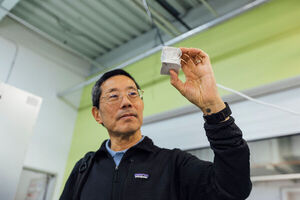
Developing electricity-powered, low-emissions alternatives to carbon-intensive industrial processes
"The Center for Electrification and Decarbonization of Industry unites MIT climate researchers to create scalable clean energy solutions under one roof. On April 11, 2022, MIT announced five multiyear flagship projects in the first-ever Climate Grand Challenges, a new initiative to tackle complex climate problems and deliver breakthrough solutions to the world as quickly as possible. This is the second article in a five-part series highlighting the most promising concepts to emerge from the competition, and the interdisciplinary research teams behind them. One of the biggest leaps that humankind could take to drastically lower greenhouse gas emissions globally would be the complete decarbonization of industry. But without finding low-cost, environmentally friendly substitutes for industrial materials, the traditional production of steel, cement, ammonia, and ethylene will continue pumping out billions of tons of carbon annually; these sectors alone are responsible for at least one third of society’s global greenhouse gas emissions. A major problem is that industrial manufacturers, whose success depends on reliable, cost-efficient, and large-scale production methods, are too heavily invested in processes that have historically been powered by fossil fuels to quickly switch to new alternatives." [...]
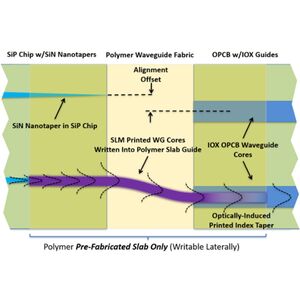
New Polymer Materials Make Fabricating Optical Interconnects Easier
"New technology poised to make silicon photonics more practical, which could boost efficiency of Internet data centers Researchers have developed new polymer materials that are ideal for making the optical links necessary to connect chip-based photonic components with board-level circuits or optical fibers. The polymers can be used to easily create interconnects between photonic chips and optical printed circuit boards, the light-based equivalent of electronic printed circuit boards. “These new materials and the processes they enable could lead to powerful new photonic modules based on silicon photonics,” said research team leader Robert Norwood from the University of Arizona. “They could also be useful for optical sensing or making holographic displays for augmented and virtual reality applications. Silicon photonics technology allows light-based components to be integrated onto a tiny chip. Although many of the basic building blocks of silicon photonic devices have been demonstrated, better methods are needed to fabricate the optical connections that link these components together to make more complex systems." [...]

Joystick-operated robot could help surgeons treat stroke remotely
"The system could provide teleoperated endovascular treatment to patients during the critical time window after a stroke begins. MIT engineers have developed a telerobotic system to help surgeons quickly and remotely treat patients experiencing a stroke or aneurysm. With a modified joystick, surgeons in one hospital may control a robotic arm at another location to safely operate on a patient during a critical window of time that could save the patient’s life and preserve their brain function. The robotic system, whose movement is controlled through magnets, is designed to remotely assist in endovascular intervention — a procedure performed in emergency situations to treat strokes caused by a blood clot. Such interventions normally require a surgeon to manually guide a thin wire to the clot, where it can physically clear the blockage or deliver drugs to break it up. One limitation of such procedures is accessibility: Neurovascular surgeons are often based at major medical institutions that are difficult to reach for patients in remote areas, particularly during the “golden hour” — the critical period after a stroke’s onset, during which treatment should be administered to minimize any damage to the brain." [...]
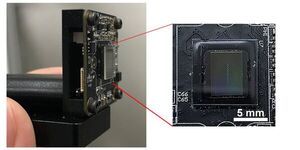
Researchers Create Miniature Wide-Angle Camera with Flat Metalenses
"New design enables high-quality wide-angle cameras that can possibly fit into smartphones Researchers have designed a new compact camera that acquires wide-angle images of high-quality using an array of metalenses — flat nanopatterned surfaces used to manipulate light. By eliminating the bulky and heavy lenses typically required for this type of imaging, the new approach could enable wide-angle cameras to be incorporated into smartphones and portable imaging devices for vehicles such as cars or drones. Tao Li and colleagues from Nanjing University in China report their new ultrathin camera in Optica, Optica Publishing Group’s journal for high-impact research. The new camera, which is just 0.3 centimeters thick, can produce clear images of a scene with a viewing angle of more than 120 degrees. Wide-angle imaging is useful for capturing large amounts of information that can create stunning, high-quality images. For machine vision applications such as autonomous driving and drone-based surveillance, wide-angle imaging can enhance performance and safety, for example by revealing an obstacle you couldn’t otherwise see while backing up in a vehicle." [...]
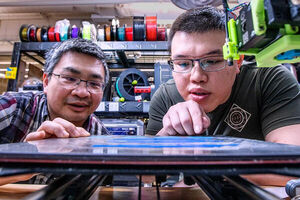
FAMU-FSU researchers improve 3D printing quality by sharing data among machines
"Researchers at the FAMU-FSU College of Engineering are improving 3D printing technology by teaching machines to learn from each other. In a new study published in the IEEE (Institute of Electrical and Electronics Engineers) Transactions on Automation Science and Engineering, researchers showed how data from one printer can be used by other machines to improve efficiency and quality. “Cloud manufacturing, along with the Internet of Things (IoT), is a newly emerging technology,” said paper co-author Hui Wang, associate professor at the FAMU-FSU College of Engineering. “The technology demonstrates that data generated from multiple production machines can be shared with each in a timely manner, and manufacturing can be enclosed as online services for meeting diverse market demands.” According to the on-demand manufacturing platform Hubs 2021 3D Printing Trends Report, the global 3D printing market grew by 21 percent in 2020, despite the effects of a worldwide pandemic. This growing industry is accelerating to print everything from metal to biological materials. The race is on to optimize these processes for competitive advantage." [...]
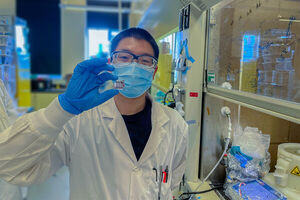
Quantum innovation advances low-cost alternative solar technology
"A team of researchers from the University of Toronto’s Faculty of Applied Science & Engineering has leveraged quantum mechanics to optimize the active layer within a device known as an inverted perovskite solar cell – a technology that could one day result in mass-market solar cells that a fraction of those currently on the market. At present, virtually all commercial solar cells are made from high-purity silicon, which takes significant energy to produce. But researchers around the world are experimenting with alternative solar technologies that could be manufactured and installed with less energy and at lower cost. One of these alternatives, which is being studied in the Sargent Group lab, is known as perovskite. The power of perovskite materials comes from their unique crystal structure, which enables them to absorb light in a very thin layer and convert it into electricity efficiently. “Perovskite crystals are made from a liquid ink and coated onto surfaces using technology that is already well-established in industry such as roll-to-roll printing,” says Hao Chen, a post-doctoral researcher in Sargent’s lab and one of four co-lead authors of a new paper published in Nature Photonics." [...]
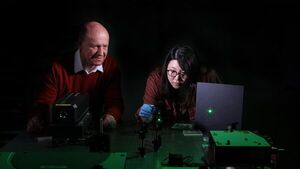
Maintaining the structure of gold and silver in alloys
"EPFL engineers have developed a low-temperature annealing method that maintains the structure of gold and silver when the two metals are combined in an alloy. Their discovery will prove useful in the manufacture of contact lenses, holographic optical elements and other optical components, since the new alloys reflect the full spectral range. Gold, silver, copper and aluminum are widely used in the manufacture of optical components because of their reflective properties. Gold, for instance, reflects red light, while silver reflects blue light. These metals are also of interest to scientists, who study them at the nanoscale, since nanostructures have a completely different optical response than bulk materials. At this scale, light interacts differently than it would with the same metal in a larger quantity, such as in a gold bar." [...]
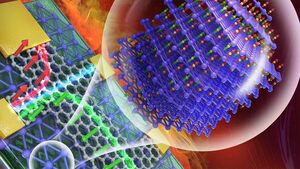
New transistor could cut 5% from world’s digital energy budget
"Design Also Poised To Save Space, Retain Memory In Event Of Power Loss A new spin on one of the 20th century’s smallest but grandest inventions, the transistor, could help feed the world’s ever-growing appetite for digital memory while slicing up to 5% of the energy from its power-hungry diet. Following years of innovations from the University of Nebraska–Lincoln’s Christian Binek and University at Buffalo’s Jonathan Bird and Keke He, the physicists recently teamed up to craft the first magneto-electric transistor. Along with curbing the energy consumption of any microelectronics that incorporate it, the team’s design could reduce the number of transistors needed to store certain data by as much as 75%, said Nebraska physicist Peter Dowben, leading to smaller devices. It could also lend those microelectronics steel-trap memory that remembers exactly where its users leave off, even after being shut down or abruptly losing power. “The implications of this most recent demonstration are profound,” said Dowben, who co-authored a recent paper on the work that graced the cover of the journal Advanced Materials. Many millions of transistors line the surface of every modern integrated circuit, or microchip, which itself is manufactured in staggering numbers — roughly 1 trillion in 2020 alone — from the industry-favorite semiconducting material, silicon." [...]

Surfing at the atomic scale: ANSTO scientists confirm experimentally new fundamental law for liquids
"The first experimental evidence to validate a newly published universal law that provides insights into the complex energy states for liquids has been found using an advanced nuclear technique at ANSTO. The work has just been published in the Journal of Physical Chemistry Letters as the editor’s choice and featured on the front cover of the journal. The equation for the vibrational density of states formulated by Alessio Zaccone and Matteo Bagglioli was published in a paper in PNAS in 2021, providing an answer to a question that has been elusive for at least a century. The elegant mathematical theory has solved the problem of obtaining the distribution of these complex energy states for liquids. “One of the most important quantities in the physics of matter is the distribution of the frequencies or vibrational energies of the waves that propagate in the material. It is particularly important as it is the starting point for calculating and understanding some fundamental properties of matter, such as specific heat and thermal conductivity, and the light-matter interaction, ”said Prof Zaccone on the University of Milan website." [...]
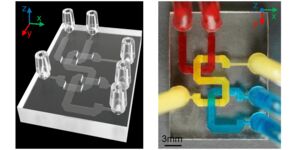
New 3D Printing Technique: A Game Changer for Medical Testing Devices
"USC Viterbi researchers have developed a 3D printing technique to fabricate microfluidic devices for biomedical applications at a microscale not previously possible. Microfluidic devices are compact testing tools made up of tiny channels carved on a chip, which allow biomedical researchers to test the properties of liquids, particles and cells at a microscale. They are crucial to drug development, diagnostic testing and medical research in areas such as cancer, diabetes and now COVID-19. However, the production of these devices is very labor intensive, with minute channels and wells that often need to be manually etched or molded into a transparent resin chip for testing. While 3D printing has offered many advantages for biomedical device manufacturing, its techniques were previously not sensitive enough to build layers with the minute detail required for microfluidic devices. Until now." [...]

Tiny labmade motors could one day suck pollutants from the air and harvest precious metals
"In three advances, scientists replicate—and in some cases improve on—the body’s own minimachines Tiny molecular machines make life possible. Spinning rotary motors generate the chemical fuel our cells need, miniature walkers carry nutrients, and minute construction crews build proteins. Now, chemists are getting in on the act by making even smaller and simpler versions of these biological machines. In three studies, scientists report designing their own molecular pumps and rotary motors. The puny devices are not quite ready to make their real-world debut, but future versions could suck carbon dioxide from the air and harvest valuable metals from seawater. The new studies show it’s possible to get teams of motors all working in the same direction and concentrate target chemicals in a confined space, a feat biology uses to sustain work." [...]

In race to build quantum computing hardware, silicon begins to shine
"In race to build quantum computing hardware, silicon begins to shine Research conducted by Princeton University physicists is paving the way for the use of silicon-based technologies in quantum computing, especially as quantum bits – the basic units of quantum computers. This research promises to accelerate the use of silicon technology as a viable alternative to other quantum computing technologies, such as superconductors or trapped ions. In research published(link is external) in the journal Science Advances, Princeton(link is external) physicists used a two-qubit silicon quantum device to achieve an unprecedented level of fidelity. At above 99 percent, this is the highest fidelity thus far achieved for a two-qubit gate in a semiconductor and is on par with the best results achieved by competing technologies. Fidelity, which is a measure of a qubit’s ability to perform error-free operations, is a key feature in the quest to develop practical and efficient quantum computing. Researchers around the world are trying to figure out which technologies — such as superconducting qubits, trapped ions or silicon spin qubits, for example — can best be employed as the basic units of quantum computing." [...]

Intense laser light modifies the pairing of electrons
"The quantum-mechanical exchange interaction between electrons, a consequence of the Pauli exclusion principle, can be specifically modified with intense infrared light fields on time scales of a few femtoseconds, as time-resolved experiments on sulfur hexafluoride molecules show. This finding lights a way for bottom-up controlling chemical reactions with lasers in the future – based purely on electrons, the “glue” of chemistry. Electrons form the bonds in molecules and play a decisive role in chemical reactions. In atoms and molecules, the electrons are arranged on a sequence of energy levels that are characterised by quantum numbers. For their occupation, the interaction of these electrons with each other – quantum mechanically called exchange interaction – also plays an important role. This is because electrons behave like miniature gyroscopes: they have a spin that can point in two directions." [...]
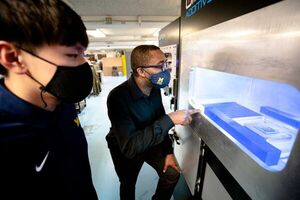
Smarter 3D printing makes better parts faster
"Software for powder bed fusion printers optimizes laser's printing path 3D printers may soon get better at producing intricate metal and plastic parts, thanks to new software developed at the University of Michigan that reduces harmful heat buildup in laser powder bed fusion printers. Called SmartScan, the software demonstrated a 41% improvement in heat distribution and a 47% reduction in deformations in a recent study. It’s also likely to speed the manufacturing process in two ways: by reducing the need for printers to slow down to help with cooling and by significantly reducing heat-caused defects that must be corrected after printing. Laser powder bed fusion is a form of 3D printing used in aerospace, automotive and biomedical industries to manufacture parts that are too intricate to make with conventional manufacturing. It uses a laser to fuse layers of powdered metal or plastic together. But the laser’s heat can build up in the delicate parts being printed, causing deformation and other defects." [...]

Researchers engineer electrically tunable graphene device to study rare physics
"An international team, co-led by researchers at The University of Manchester’s National Graphene Institute (NGI) in the U.K. and the Penn State College of Engineering in the U.S., has developed a tunable graphene-based platform that allows for fine control over the interaction between light and matter in the terahertz (THz) spectrum to reveal rare phenomena known as exceptional points. The team published their results today (April 8) in Science. The work could advance optoelectronic technologies to better generate, control and sense light and potentially impact wireless communications, according to the researchers. They demonstrated a way to control THz waves, which exist at frequencies between those of microwaves and infrared waves. The feat could contribute to the development of beyond-5G wireless technology for high-speed communication networks. Weak and strong interactions Light and matter can couple, interacting at different levels: weakly -- where they might be correlated but do not change each other’s constituents -- or strongly -- where their interactions can fundamentally change the system." [...]
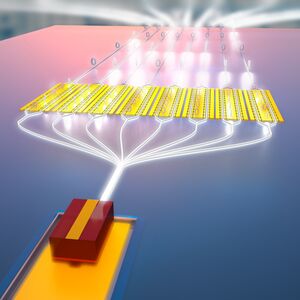
First integrated laser on lithium niobate chip
"Research paves the way for high-powered telecommunication systems For all the recent advances in integrated lithium niobate photonic circuits — from frequency combs to frequency converters and modulators — one big component has remained frustratingly difficult to integrate: lasers. Long haul telecommunication networks, data center optical interconnects, and microwave photonic systems all rely on lasers to generate an optical carrier used in data transmission. In most cases, lasers are stand-alone devices, external to the modulators, making the whole system more expensive and less stable and scalable. Now, researchers from the Harvard John A. Paulson School of Engineering and Applied Sciences (SEAS) in collaboration with industry partners at Freedom Photonics and HyperLight Corporation, have developed the first fully integrated high-power laser on a lithium niobate chip, paving the way for high-powered telecommunication systems, fully integrated spectrometers, optical remote sensing, and efficient frequency conversion for quantum networks, among other applications. “Integrated lithium niobate photonics is a promising platform for the development of high-performance chip-scale optical systems, but getting a laser onto a lithium niobate chip has proved to be one of the biggest design challenges,” said Marko Loncar, the Tiantsai Lin Professor of Electrical Engineering and Applied Physics at SEAS and senior author of the study. “In this research, we used all the nano-fabrication tricks and techniques learned from previous developments in integrated lithium niobate photonics to overcome those challenges and achieve the goal of integrating a high-powered laser on a thin-film lithium niobate platform.” The research is published in the journal Optica." [...]
Projetos Maker
Diversos Projetos interessantes.

AMG8833 Thermal Camera
"Cheap and easy to build using VirtualPanel AMG8833 Thermal Camera Based on the AMG8833 Grid-EYE sensor by Panasonic I built a simple thermal camera by hooking up the sensor module to an Arduino Uno (4 wires). Using VirtualPanel as display and control panel it was easy to build a usable camera. Part of the challenge was to make this work on a ATMega328 (Uno, Nano) which has limited memory and processing power. I think I succeeded although the frame rate could be better. AMG8833 Module The AMG8833 Grid-EYE is a low cost infrared sensor array developed by Panasonic. For use with microcontrollers it is integrated in a module with level shifters and voltage regulator allowing 3 - 5v power and data." [...]

Reverse-engineering the LM185 voltage reference chip and its bandgap reference
"Many circuits, such as a computer power supply or a phone charger, require a stable voltage reference, but it's harder than you might expect to keep a voltage stable when the temperature changes. One integrated circuit that does this is the LM185.1 I looked at the die of this chip and found some interesting features. The same silicon die is used for three different integrated circuits, using tiny internal fuses to change its functionality. The chip uses a special circuit called the bandgap reference to keep the voltage stable even if the temperature changes. In this blog post, I'll discuss the circuitry of the LM185 and its implementation in silicon. The photo above shows the LM185 die under the microscope, a tiny square of silicon." [...]

Smoke detector using MQ-2 Gas sensor
"In this tutorial, we will see how to make a smoke detector that will help prevent smoking in public areas. Smoking is extremely hazardous to health. Even in the smoking areas, people intend to smoke. This passive smoke is unhealthy for other surrounding people. That’s why I have developed a smoke detector for no-smoking zones. A pair of these devices can be installed in the no-smoking zones of hotels, hospitals, malls, etc." [...]

POV without mechanical equipment
"There are many POV projects, but all of them need special mechanical parts, special tools and good skills. This is a way to go without it. At the time of writing, when I did a search for "POV" on Hackster, it gave me 63 hits. But most of them require very special parts and tools and a lot of time to build. Some other come with only five LEDs. O.k., in principle it will work, but it looks very poor." [...]

Solar weather station
"This kit get charged from solat battery and provides information about temperature, light level, CO2 level and moisture level of the soil. As warm time of the year approaches, people spend more time outside and there's a need for measuring outside parameters devices. I connected the sensors and a solar battery to micro:bit device to measure different parameters. This is a very convenient and easy to use a weather station that can run independently without batteries or USB connection to the computer. It contains four sensors - a temperature sensor to get air temperature, a CO2 sensor to receive information about a pollution level, a light level sensor and a moisture sensor to detect the state of the soil for a possible pique-nique on the grass or for sport games. Each sensor provides specific information: A grove temperature sensor gives information about air temperature in C°." [...]

The Centaurus (Mark 1)
"Heavy-duty and Swift movement from DC Motors with control from an IR Remote, and a fashionable mustache for the ladies. The chassis of Centaurus is mostly made from wood except for the wheels that are made from plastic. The available buttons on the IR Remote are: forward, back, left, right, number symbol (#) starts a binary countdown, and star symbol (*) that initiates free-roam obstacle avoidance mode. The Arduino board inside of the chassis is powered by a rechargeable battery that was extracted from an Elegoo Robot Car Kit, the link for the kit is in the lists of components above, but this is not necessary, as you can use any 12V power supply. The name Centaurus comes from one of my favorite constellations inside the milky way galaxy. The idea was designed and programmed to be efficient with its maneuverability and precision, all while being controlled with just a tap of a button, and my favorite, the unique pattern of shifting LEDs attached." [...]

A "Tree of Light" Prototype
"A "Tree of Light" with 9 plexiglass discs each adorned with LEDs arranged in a flower shape. What’s it for? This 4-foot tall structure is a prototype for a larger LED structure we’re building this year that we’re calling the “Tree of Light”. The actual final structure will be somewhere around 35-40 ft tall, but since it will take time to build, we decided to build a smaller prototype, so that I can start writing code and figuring out the algorithms for the light patterns. " [...]
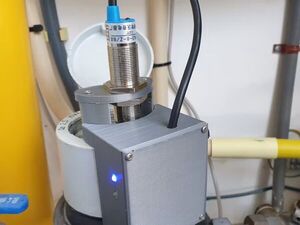
Smart Water Meter
"This Smart Water Meter has an inductive proximity sensor connected to an ESP32 is programmed in ARDUINO and uses the BLYNK IoT platform. Story While energy prices are increasing every day, the prices of water are (still) moderate compared to gas and electricity. Nevertheless, there are good reasons to save on water usage, e.g. when you realise that while taking a shower a lot of hot water is used and it is costing energy to heat up the water. In other words: a lot of energy is washed away every day. Although you can see the water usage on the meter itself, it does not tell you how much water is being used for taking a shower or flushing the toilet, or watering your plants in the garden." [...]
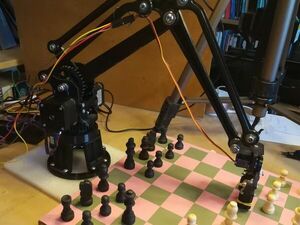
Chess Playing Robot Arm That Will Beat You!
"It uses a 3D printed arm from free resources with my code to recognise the human moves and control the arm I wanted to build a chess robot that could play and beat me. I had previously made one using a commercial kit (AL5D) but it is quite expensive. And so I decided to 3D-print a robot and rewrite my code for it. It works like this: The human, playing white, makes a move. This is detected by the visual recognition system. The robot then ponders and then makes its move." [...]

USB Joystick using Arduino for Robotics and Computer Game
"We are going to make an amazing compact joystick using Arduino. We can use this joystick to control our DIY Robots and PC Gaming. Hey guys, in this video, we are going to make an amazing compact joystick using Arduino. We can use this joystick to control our DIY Robots or connect it to your computer and play games with it! Awesome right? So let’s get started!" [...]
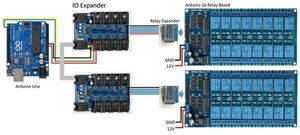
9-Bit Multidrop Communications
"Connect multiple IO Expanders together using a 9-bit multidrop communications. Story RS232 is typically used as a point to point (P2P) communications network. To amplify the signal to go long distances, transceivers (7-12V) were used, which constrained the communications to P2P. With the removal of the transceivers for a cheaper RS232 using CMOS transistor-transistor logic (TTL) levels (3.3-5V), it now became possible to implement point to multipoint (P2MP). A P2MP network can be created by using a Master to multiple Slaves with 9-bit data where the 9th bit is used to indicate an address byte. Every Slave has a unique board address." [...]

Arduino serial Programmer CH340N
"Small USB to Serial programmer module, with Type C port and having compatibility with Arduino micro-controller. There are lot of programmer boards that are compatible with Arduino. But the cheapest and smaller one I found on internet is based on WCH made CH340 ic. And I also found that USB to serial programmer in many Arduinos clone boards. " [...]

AquaPing
"Battery powered, stand-off acoustic water leak detection Story The AquaPing is an ultra-low power smart sensor that provides stand-off water leak detection -- even for leaks behind walls. No contact with plumbing is needed. All signal processing and analysis occurs at the edge, so no audio is streamed to the cloud. Eavesdropping is impossible. When pressurized water escapes from a seam, crack, or loose fitting on plumbing, broadband high frequency acoustics are emitted. These signals can travel 10m or more in free-space and be detected by a remote sensor." [...]

IoT Based Smart and Secure Lock V2.0
"In this project we've built IoT based smart and secure lock which have 4 layers of access. RFID + PIN + Fingerprint + OTP. In this project we've built IoT based smart lock which have 4 layers of access. RFID + PIN + Fingerprint + OTP. We have slightly upgraded our previous version of the project. In this version we are going to add one more accessibility layer." [...]

DIY E-Paper Retro Style Picture Frame (LilyGo EPD47 & ESP32)
"How to upload any image to E-paper display. With this display you can make a beautiful retro look B/W picture frame Story This time I will show you how to upload any image to E-paper display. Specifically it is about LilyGo T5 4.7-inch E-paper which has the following characteristics: - ESP32 dual core MCU - 4.7-inch integrated e-paper display - 540x960 pixels, 16 gray levels - Allows usage of a touch screen - 16MB flash - 8MB PSRAM memory - USB-C port - built-in LiPo/Li-Ion battery charger - integrated 18650 Li-Ion battery holder - and 5 general purpose buttons With this display you can make a beautiful retro look picture frame on which to change black and white images. This is made possible by the 16 gray levels that has this display. You must first download and install the display library. You can download it from the link: https://github.com/Xinyuan-LilyGO/LilyGo-EPD47 This library comes with 4 examples." [...]

Car Parking Simulator
"A simulation of a real life car parking using Arduino, Ultrasonic sensors, LCD Display and RGB LEDs. This project is based on some car parkings, which is, an indication if the local is free or occupied, so for the simulation, I'm going to use two ultrasonic sensors, simulating two parking spots, two RGB LEDs, indicating if is occupied or not, and an I2C LCD display to show informations with images. Thinking on that, I want to make a simple project to show this simulation and I hope I'm helping someone who was trying to do, but wasn't with any idea of how to. Some solutions The first idea is to make a small, simple and functional project, so I'm not going to use too much wires, components, etc. Instead of using two red LEDs and two green LEDs, I'm going to use only two RGB LEDs, using only red and green lights from it. Here I'm using I2C LCD Display to show the images, because it just need four wires and doesn't use any digital port." [...]

Arduino Pinball Machine That Plays Itself!
""A pinball machine that plays itself, doesn't that take all the fun out of it?" I hear you ask. Maybe if you're not into autonomous robots it might. Me, however, I'm very much all about building robots that can do cool stuff, and this one does some pretty cool stuff. This project was built as a senior design project for Kennesaw State University, and was a literal childhood dream come true for me to build. The features include a working score system that tracks how many points you get, a multiball plinko machine, and an autonomous activation switch on the front that you can flip on-the-fly." [...]

A Clock of Retrograde Minutes and Jumping Hours
"A desk clock with retrograde minutes and jumping hours mechanisms. Retrograde minutes : The minute hand moves reciprocallyJumping hour : Numerical hour display that changes instantly" [...]
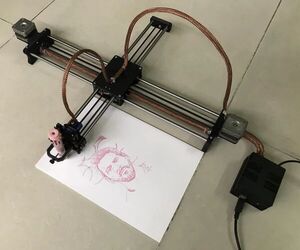
Multicolor DrawBot
"I have seen many versions of the COREXY Drawbots and almost no one has enabled "Homing" function for them, even though the design already had space to fit limit switches. Today, I'd like to share how a CoreXY Drawbot can draw colorful shapes or texts by enabling its "Homing" function. Main materials: - 1set x 3D printed parts, available at: https://www.thingiverse.com/thing:2349232/files - 1pcs x Arduino UNO R3 or Combo Arduino + CNCShield + A4988. - 1pcs x Arduino CNC Shield V3 GRBL. - 2pcs x Stepper Motor Driver A4988. - 2pcs x Stepper motor NEMA 17." [...]
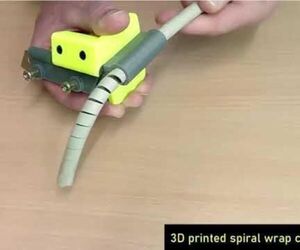
Spiral Wraps Out of Hoses or Cable Sleeve Ends
"With this cutter you can make your own spiral wraps out of left over hose pieces or cable sleeve ends. The Spiral cutter is 3d printable. You can download the 3D model from Thingiverse: https://www.thingiverse.com/thing:5339697 The cable guide tube is customizable, so you can design your own cable guide diameter tube accordingto the hose to cut. The intention is to re-use old hose or cable sleeve pieces You already had the problem, to organize your cables and bind them together, but you didn't have the right spiral wrap on hand ? Then this tool may be for you. The following parts are needed to mount the ready printed parts together: - 1 sharp Cutter knife 100 x 18 x0.5 mm - 2 screws M4x12 - with your desired flat screw head - 2 screws M4x16 DIN 912 (Allen screws with flat head) - 2 Nuts M4 - 2 screws M6x8 - with your desired flat screw head - also worm screws can be used." [...]

CUBOTino: a Small, Simple, 3D Printed, Inexpensive Rubik's Cube Solver Robot (Base Version)
"This is my second Rubik's cube solver robot; This time I wanted to make it very small, simple, fully 3D printed, and inexpensive..... to attract more people into robotics, especially students. The overal project considers the robot, to be scalable, to accomodate different budjet levels. This instruction relates to the base version, as the more advanced versions are still work in progress; Main info, for this Base version: It requires a PC for the cube status entry, via webcam or via mouse, and to "feed" the robot with the cube solution (based on Kociemba solver). An ESP32 development board, programmed in Micropython, controls the robot and the two servos used for all the movements. The interraction is supported by a GUI, coded in Python; A setting page at GUI helps with the basic robot settings. The robot is energized via the microusb port, the same is used for the communications." [...]
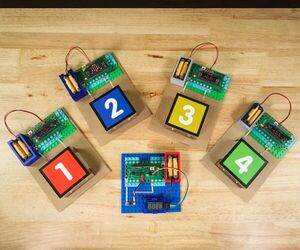
Wireless Game Show Buzzer System
"Build your own Game Show Buzzer System with large "slammer" buttons for up to four teams/players. It's all powered by a bunch of micro:bits and a Crazy Circuits Bit Boards. Note: This is the "wireless" version of our simpler Game Show Buzzer System. You need a lot more parts, but you need a lot less tape & wires. For this project we are using these Cardboard Buttons made with Maker Tape. Follow the guide and build your own so you can use them with this project!" [...]
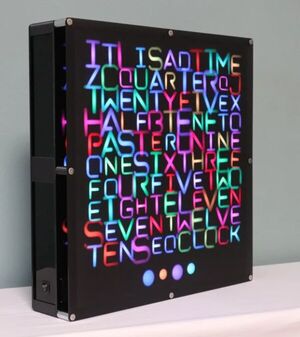
Servo Wordclock V2
"3 years ago we finished building a word clock controlled by 114 servos. In this variation of the popular clock, letters are projected from the back onto a screen. Each letter is connected to a linear actuator that can be moved back and forth by a servo so that the projection changes size and focus onto the screen. Since we got a lot of positive feedback for our clock we started to work on an improved version. Version 1 of the clock looked great but the building process was very tedious and would make it almost impossible for other people to recreate. In this project, we did a complete redesign of the clock with the goal to make it more reliable and greatly ease the assembly process." [...]
Secção Videos
Videos interessantes.
- MOTORS -The Secret Life of Components, a series of guides for makers and designers 11
- Building a PC soundbar... with a twist!
- DIY Animatronic Eyeball with Wii Nunchuck Control!
That's all Folks!



